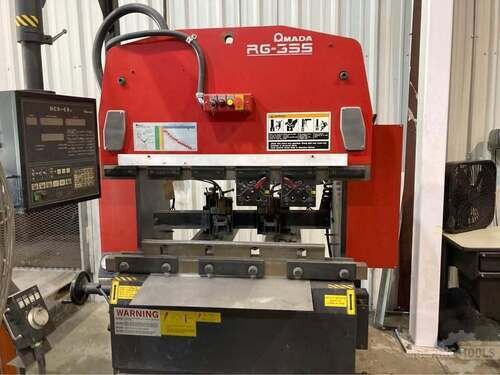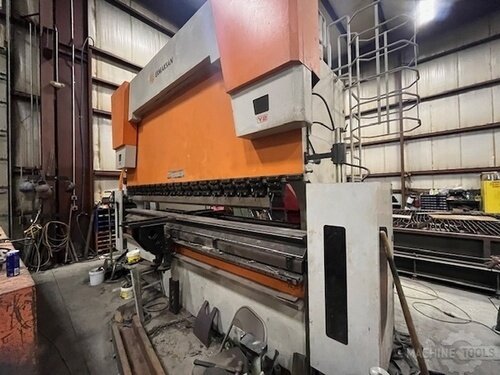Year-End Aerospace ROI: Ermaksan Heavy-Duty Press Brakes, Section 179
As President of Mac-Tech, I help aerospace fabricators align capital investment with quarterly targets and long-term resilience. Aviation parts require unmatched accuracy, and the timing of your purchases matters as much as the technical capability you install. With Ermaksan heavy-duty press brakes, we pair precision bending with disciplined implementation, then leverage Section 179 before year-end to protect cash, strengthen EBITDA, and position your shop for a strong Q1 start.
Section 179 as a Strategic Lever: Turn Q4 Tax Exposure into Ermaksan Bending Capacity
Section 179 is more than a deduction. It is a timing tool that converts tax exposure into productive capacity when you place equipment in service by year-end. For 2024, the Section 179 deduction limit is $1,220,000 with a phase-out beginning at $3,050,000. Bonus depreciation is available at 60 percent this year on qualifying purchases after Section 179 is applied. Used and new machines qualify, and financed equipment can still receive the benefit if installed and operational before December 31.
This is why we front-load delivery, installation, and training schedules in Q4 for aerospace clients. We map your forecasted loads, commit to commissioning dates, and coordinate with your CPA so the deduction aligns with cash flow, loan covenants, and budget rollovers. The result is a press brake that starts generating throughput this quarter, a tax deduction that reduces your effective acquisition cost, and a head start on the next build cycle.
Aerospace Precision at Scale: Heavy-Duty Press Brakes that Shorten Lead Times and Reduce Rework
Ermaksan’s heavy-duty Speed-Bend Pro series is built for tight tolerances on demanding materials such as aluminum alloys, stainless, and high-nickel aerospace grades. The machines use high-resolution linear scales mounted on the frame, CNC crowning, and a rigid monoblock body to hold angle consistency across long parts and high tonnages. With Delem DA-66T or DA-69T CNC controls, you get 2D or 3D programming, bend sequence simulation, and collision checking that reduce trial-and-error.
For aerospace, angle consistency is everything. Integrated angle control options, such as laser-based systems compatible with the Delem platform, monitor actual bend angles in real time and apply closed-loop corrections. Paired with 6 axis backgauging and precision tooling, our customers routinely achieve first-off angles within ±0.5 degree, and tighter when using active angle measurement. That level of control shortens first article approval time, trims NCMR activity, and reduces rework across long-run and spares programs.
ERMAK EVOIII 3760-175
- Ermak EvoIII 3760-175 (193 Ton x 12’)
- 7-Axis: Y1, Y2, X, R, Z1, Z2, X-Prime (+/-3.94”)
- Delem 66Touch CNC Control, 17”
- CNC Motorized Crowning
- Precision Tooling Package
ERMAKSAN POWER-BEND FALCON BENDING MACHING
Hard Numbers, Fast Payback: Cycle Time, First-Pass Yield, Scrap, and Energy Savings that Justify the CapEx
ROI on a heavy-duty brake is not a single lever. It is the compounding effect of cycle time, first-pass yield, scrap reduction, and energy savings. Typical programs we see in aerospace realize 15 to 30 percent shorter cycle times from faster approach and retract speeds, intelligent bend sequencing, and 6 axis backgauging that eliminates manual repositioning. First-pass yield improvements of 5 to 15 points are common when moving from manual corrections to closed-loop angle control and CNC crowning.
Energy use is a meaningful line item on larger brakes. Ermaksan offers energy-efficient hydraulic packages that modulate pump output to demand. Depending on duty cycle and tonnage mix, customers often see 30 to 50 percent energy savings versus conventional hydraulic drives. Combine those savings with a reduction in scrap on expensive alloys and a Section 179 deduction, and paybacks of 12 to 24 months on a heavy-duty system are realistic for shops with steady flight hardware or MRO volumes. We build a model with your part mix and labor rates so the business case is transparent.
Automation and Data Discipline: Offline Programming, Angle Control, and 6 axis Backgauging for Predictable Flow
Predictable flow is the backbone of on-time delivery. Delem-based offline programming, such as Profile-T, lets your team program bends from CAD, simulate sequences, and set up tooling virtually. That means fewer on-machine interruptions and faster changeovers. With 6 axis backgauging across X, X1, X2, R, Z1, Z2, operators can reposition complex parts without manual handling, which improves repeatability and reduces ergonomic risk.
Closed-loop angle control moves bending from operator feel to measurable data. Real-time angle feedback tightens Cpk on critical bends and documents compliance for AS9100 audits. Add machine connectivity for production data capture and you can track OEE, planned versus actual cycle times, and first-pass yield. The result is a bending cell that behaves like an accountable process center, not a black box.
The Total Cost Story: Tooling Standardization, Service Uptime, and Risk Controls that Protect EBITDA
Tooling strategy drives uptime. We help standardize on Wila or American style precision tooling with hydraulic or quick-clamp systems so operators can change over rapidly with fewer shims. CNC crowning, precision dies, and staged setups allow multiple bends in one pass, which cuts handling time and limits WIP queues. Standardization also simplifies spares and reduces the number of unique components that tie up cash.
Uptime protection comes from service, training, and safe operation. Ermaksan brakes are equipped with modern safety systems, including light curtains and LazerSafe-compatible guarding. Delem controls support remote diagnostics that help our service team resolve issues quickly. We offer preventive maintenance plans, stocked spares, and operator training to reduce unplanned downtime. The combination of safe work practices, documented procedures, and predictable service response is a direct hedge against EBITDA volatility.
Mac-Tech Partnership: Assessment, Trade-In, Financing, and Lifecycle Support that Build Durable Advantage
My team starts with a floor walk and part review. We measure bend complexity, length, material mix, and takt time, then size the right brake and backgauge configuration. If you are replacing older capacity, we can coordinate trade-in valuation and removal to limit disruption. For financing, we align terms to your depreciation strategy, including options that facilitate Section 179 and bonus depreciation where appropriate.
Post-sale, we stay with you. Installation, commissioning, and operator training are scheduled to hit your year-end in-service milestone. We help you implement offline programming, set up standardized tooling libraries, and define KPIs for throughput and quality. From there, our service team supports preventive maintenance, upgrades, and expansion. You get a capable machine, a tax-savvy acquisition plan, and a partner focused on your long-term advantage.
FAQ
What models does Mac-Tech recommend for heavy-duty aerospace bending?
For high tonnage and long parts, we commonly deploy Ermaksan Speed-Bend Pro configurations with Delem DA-66T or DA-69T controls, CNC crowning, and 6 axis backgauging. We size tonnage and bed length to your material and geometry requirements.Can Section 179 apply if the machine is financed and delivered late in Q4?
Yes, Section 179 applies to financed equipment as long as it is purchased and placed into service by year-end. Coordinate with your CPA and our installation team to ensure commissioning dates are met.How does offline programming improve aerospace lead times?
Offline programming shifts programming effort off the machine, validates bend sequences, and reduces trial bends. That keeps the brake cutting parts instead of waiting for setups and reduces the time to first good piece.What angle tolerances can I expect on titanium and stainless?
With proper tooling, CNC crowning, and closed-loop angle control, aerospace shops routinely hold ±0.5 degree on production work, and tighter on well-characterized parts. We validate your tolerance stack during trials.What is the typical energy savings versus older hydraulic brakes?
Ermaksan’s energy-efficient hydraulic packages can deliver 30 to 50 percent energy savings depending on your duty cycle and tonnage profile. We benchmark your current usage and build a payback model.Do used machines qualify for Section 179 and can Mac-Tech handle trade-ins?
Yes, used equipment can qualify under Section 179. We manage trade-ins, inspection, and logistics so you can modernize capacity without extended downtime.- How quickly can Mac-Tech deliver and install before year-end?
Lead times vary by configuration. We prioritize Q4 projects with reserved installation windows. Contact me directly so we can lock in a commissioning date aligned to your tax planning.
I am Joe Ryan, President of Mac-Tech. If you want a precise, proven plan to turn year-end tax exposure into aerospace bending capacity, email me at joe@mac-tech.com or call 414-477-8772. We will build your ROI case, align financing and Section 179, and deliver an Ermaksan solution that is as efficient as your production lines.
Get Weekly Mac-Tech News & Updates








